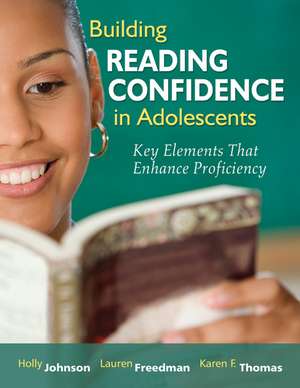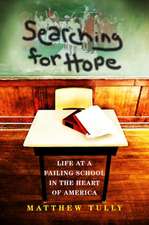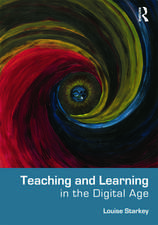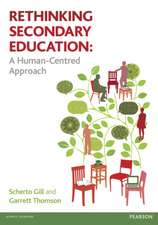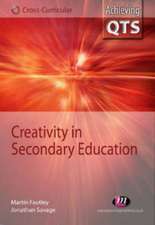Building Reading Confidence in Adolescents: Key Elements That Enhance Proficiency
Autor Holly A. Johnson, Lauren Freedman, Karen F. Thomasen Limba Engleză Paperback – 11 feb 2008
| Toate formatele și edițiile | Preț | Express |
|---|---|---|
| Paperback (1) | 219.04 lei 6-8 săpt. | |
| SAGE Publications – 11 feb 2008 | 219.04 lei 6-8 săpt. | |
| Hardback (1) | 447.72 lei 6-8 săpt. | |
| SAGE Publications – 25 feb 2008 | 447.72 lei 6-8 săpt. |
Preț: 219.04 lei
Nou
Puncte Express: 329
Preț estimativ în valută:
41.91€ • 43.76$ • 34.61£
41.91€ • 43.76$ • 34.61£
Carte tipărită la comandă
Livrare economică 15-29 aprilie
Preluare comenzi: 021 569.72.76
Specificații
ISBN-13: 9781412953535
ISBN-10: 1412953537
Pagini: 112
Dimensiuni: 216 x 279 x 7 mm
Greutate: 0.32 kg
Ediția:1
Editura: SAGE Publications
Colecția Corwin
Locul publicării:Thousand Oaks, United States
ISBN-10: 1412953537
Pagini: 112
Dimensiuni: 216 x 279 x 7 mm
Greutate: 0.32 kg
Ediția:1
Editura: SAGE Publications
Colecția Corwin
Locul publicării:Thousand Oaks, United States
Recenzii
"A tremendous book. Research shows and teachers know that motivation is a central challenge facing teachers today. This text provides fresh insight into self-efficacy, an essential component of motivation, by exploring what it is, how to cultivate it, and how to nurture it in the context of innovative teaching that develops literacy competence in a range of areas."
"Both practicing and preservice educators from all content areas need this amazing collection of constructive concepts and strategies that affect adolescent readers' attitudes toward academic and non-academic literacy. This book not only exposes educators to why facilitating engagement with reading is important, but also shares how to help adolescent readers enjoy a lifelong relationship with literacy."
"Both practicing and preservice educators from all content areas need this amazing collection of constructive concepts and strategies that affect adolescent readers' attitudes toward academic and non-academic literacy. This book not only exposes educators to why facilitating engagement with reading is important, but also shares how to help adolescent readers enjoy a lifelong relationship with literacy."
Cuprins
Introduction
Why Is Self-Efficacy Important in Reading?
The Purpose of the Text
The Audience for This Text
Outline of the Text
1. The Four Elements of Reading Self-Efficacy
Identifying the Self-Efficacy Elements of C-I-M-S
Confidence
Independence
Metacognition
Stamina
Self-Efficacy and the Cueing System
Learning from Teachers and Students
Validating and Violating C-I-M-S
Validation of Readers' C-I-M-S
Environmental Elements
Teaching/Learning Dialectic
Curricular Decisions
Affective Issues
Strategies
Violation of Readers' C-I-M-S
Concluding Comments
2. A Closer Look at Confidence and Reading
What Teachers Have to Say About Confidence and Reading
Teaching and Learning
Curriculum Planning for Enhancing Reading Confidence
Affective Interactions and Confidence
Strategies for Building Readers' Confidence
What Students Have to Say About Confidence
Teaching and Learning
Curriculum Planning for Enhancing Reading Confidence
Affective Interactions and Confidence
Strategies for Building Readers' Confidence
Comparing Teacher and Student Thoughts on Reading Confidence
An Environment That Builds Confidence
Reading in Content Classrooms
Classroom Practices for Building Reading Proficiency
Strategies for Building Readers' Confidence
Class Meetings About Reading
Using Authentic Texts
Accessing Prior Knowledge
Making Connections to Reading
Paired Reading With Peers
Paired Reading With Younger Readers
Word Walls
Using Text Sets
Retrospective Miscue Analysis
Concluding Remarks
3. The Importance of Independence for Gaining Reading Proficiency
What Teachers Have to Say About Independence
Teaching and Learning
Curriculum Planning for Enhancing Reading Independence
Affective Interactions and Independence
Strategies for Building Readers' Independence
What Students Have to Say About Independence
Teaching and Learning
Curriculum and Reading
Affective Interactions and Independence
Reading Strategies to Enhance Independence
Comparing Teacher and Student Responses to Reading Independence
An Environment for Developing Independence
Classroom Conditions That Create Reading Independence
Scaffolding Reading Independence
Strategies for Creating Reading Independence
Interest Inventories
Silent Reading
Questioning the Author
Student Think Alouds
Note-Taking
Skimming, Scanning, Browsing
Concluding Remarks
4. A Closer Look at Metacognition and Its Role in Reading Proficiency
What Teachers Have to Say About Metacognition
Environment
Teaching and Learning Relationships
Curricular Planning to Foster Metacognitive Awareness
Affective Decisions and Metacognition
Strategies to Build Metacognition
What Students Have to Say About Metacognition and Reading
Environment
Teaching and Learning Relationships
Curricular Decisions
Affective Decisions
Comparing Teacher and Student Responses to Metacognition
Creating More Strategic Readers
Are We Preparing Metacognitive Teachers?
Concluding Remarks
5. The Significance of Stamina in Reading Proficiency
What Teachers Have to Say About Stamina
Teaching and Learning
Curricular Decisions That Enhance Reading Stamina
Affective Decisions and Stamina
What Students Have to Say About Stamina and Reading
Teaching and Learning
Curricular Decisions
Affective Decisions
Comparing Teacher and Student Thought on Stamina
An Environment for Building Readers' Stamina
Strategies for Building Readers' Stamina
Support Strategies
Graphic Organizers
Categorization of Information
Knowledge Charts
Choice Strategies
Wondering and Wandering
Assessment Strategies
Concluding Remarks
6. Developing Curriculum That Addresses Self-Efficacy
Addressing Self-Efficacy in the Classroom
Curricular and Instructional Models
Rigor
Relevance
Relationship
Text Sets of Multiple Print Materials
Rigor
Relevance
Relationship
Choice and Voice
Rigor
Relevance
Relationship
Sustained Time for Reading, Writing, Talking, Thinking, and Sharing
Rigor
Relevance
Relationship
Where Do We Go From Here?
References
Index
Why Is Self-Efficacy Important in Reading?
The Purpose of the Text
The Audience for This Text
Outline of the Text
1. The Four Elements of Reading Self-Efficacy
Identifying the Self-Efficacy Elements of C-I-M-S
Confidence
Independence
Metacognition
Stamina
Self-Efficacy and the Cueing System
Learning from Teachers and Students
Validating and Violating C-I-M-S
Validation of Readers' C-I-M-S
Environmental Elements
Teaching/Learning Dialectic
Curricular Decisions
Affective Issues
Strategies
Violation of Readers' C-I-M-S
Concluding Comments
2. A Closer Look at Confidence and Reading
What Teachers Have to Say About Confidence and Reading
Teaching and Learning
Curriculum Planning for Enhancing Reading Confidence
Affective Interactions and Confidence
Strategies for Building Readers' Confidence
What Students Have to Say About Confidence
Teaching and Learning
Curriculum Planning for Enhancing Reading Confidence
Affective Interactions and Confidence
Strategies for Building Readers' Confidence
Comparing Teacher and Student Thoughts on Reading Confidence
An Environment That Builds Confidence
Reading in Content Classrooms
Classroom Practices for Building Reading Proficiency
Strategies for Building Readers' Confidence
Class Meetings About Reading
Using Authentic Texts
Accessing Prior Knowledge
Making Connections to Reading
Paired Reading With Peers
Paired Reading With Younger Readers
Word Walls
Using Text Sets
Retrospective Miscue Analysis
Concluding Remarks
3. The Importance of Independence for Gaining Reading Proficiency
What Teachers Have to Say About Independence
Teaching and Learning
Curriculum Planning for Enhancing Reading Independence
Affective Interactions and Independence
Strategies for Building Readers' Independence
What Students Have to Say About Independence
Teaching and Learning
Curriculum and Reading
Affective Interactions and Independence
Reading Strategies to Enhance Independence
Comparing Teacher and Student Responses to Reading Independence
An Environment for Developing Independence
Classroom Conditions That Create Reading Independence
Scaffolding Reading Independence
Strategies for Creating Reading Independence
Interest Inventories
Silent Reading
Questioning the Author
Student Think Alouds
Note-Taking
Skimming, Scanning, Browsing
Concluding Remarks
4. A Closer Look at Metacognition and Its Role in Reading Proficiency
What Teachers Have to Say About Metacognition
Environment
Teaching and Learning Relationships
Curricular Planning to Foster Metacognitive Awareness
Affective Decisions and Metacognition
Strategies to Build Metacognition
What Students Have to Say About Metacognition and Reading
Environment
Teaching and Learning Relationships
Curricular Decisions
Affective Decisions
Comparing Teacher and Student Responses to Metacognition
Creating More Strategic Readers
Are We Preparing Metacognitive Teachers?
Concluding Remarks
5. The Significance of Stamina in Reading Proficiency
What Teachers Have to Say About Stamina
Teaching and Learning
Curricular Decisions That Enhance Reading Stamina
Affective Decisions and Stamina
What Students Have to Say About Stamina and Reading
Teaching and Learning
Curricular Decisions
Affective Decisions
Comparing Teacher and Student Thought on Stamina
An Environment for Building Readers' Stamina
Strategies for Building Readers' Stamina
Support Strategies
Graphic Organizers
Categorization of Information
Knowledge Charts
Choice Strategies
Wondering and Wandering
Assessment Strategies
Concluding Remarks
6. Developing Curriculum That Addresses Self-Efficacy
Addressing Self-Efficacy in the Classroom
Curricular and Instructional Models
Rigor
Relevance
Relationship
Text Sets of Multiple Print Materials
Rigor
Relevance
Relationship
Choice and Voice
Rigor
Relevance
Relationship
Sustained Time for Reading, Writing, Talking, Thinking, and Sharing
Rigor
Relevance
Relationship
Where Do We Go From Here?
References
Index
Notă biografică
Holly Johnson is an Associate Professor in the Division of Teacher Education at the University of Cincinnati. where she teaches adolescent literacy courses for students interested in becoming middle school teachers. Her research focuses on adolescent literacy and literature, and issues of social justice. She taught middle school language arts and social studies in Kentucky and Arizona, and was an industrial arts teacher in Botswana, Africa as a Peace Corps Volunteer.
Descriere
The authors present a research-based approach for building reading self-efficacy and focus on four concepts necessary to learners' literacy success: confidence, independence, metacognition, and stamina.
